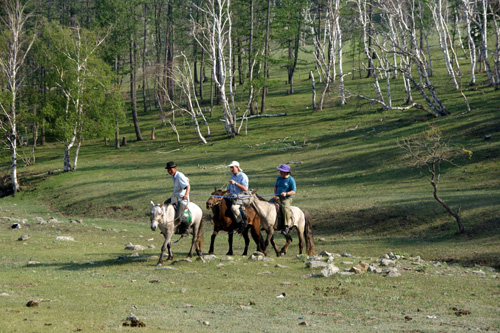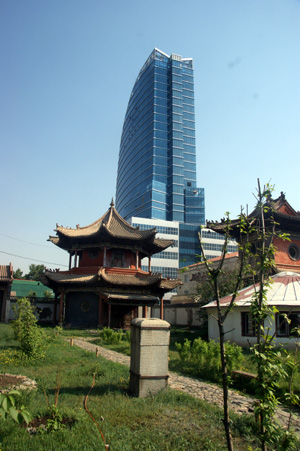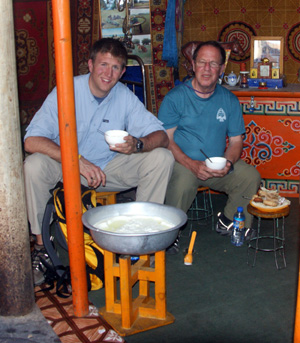JR often says, “This is just like Scout camp.” He’s usually right, but this time, he’s more right because Mongolia does resemble Scout camp in many ways. The Lonely Planet, for example, describes it as “The world’s largest campground,” and while there are a lot of places I wouldn’t want to pitch a tent, there are many that I could. With one million people in Ulan Bataar, and 500,000 in the second largest city, Mongolia has one of the lowest population densities in the world.
We discovered the “big sky” country on our 350 km trip from UB to Karakorum, one of the few ancient cities in a country dominated by nomads; even today, about 25 per cent of the population lives a nomadic existence, and about half, we’re told, live in the ger tent (a yurt is a more well-known name for the circular felt tent that is characteristic of Asian nomads. The road in places is no better than the road in Scout camp, and it, like most roads between cities here, is a toll road. Parts of it were under construction (ongoing, said our guide, for the past four years, and expected to be completed in four years). The “detours” are paths suitable (barely) for four-wheel drive vehicles, and we hung on dearly as our driver navigated one of several choices until we got back on the standard two-lane “toll road” to the northwest.
Like Mongolia, where 50% of the population live in the gers, we’re spending two nights in gers and two nights in hotels. Yesterday, after leaving UB, we drove most of the day, making two stops. One was at a sand dune that resembles the Great Sand Dunes national monument, without the backdrop of 14,000-foot mountains of Colorado, but with some mountains in the background, and about a 60-mile swath that is a haven for wild life. One of the main tourist attractions is in fact the outdoors—the Gobi in the South, the mountains in the North, and the wildlife in both places. The big sky panoramas are sweeping and spectacular—miles of space, with few gers, fewer towns (none that really merit the name until Karakorum), and herds—of sheep, goats, cows, and horses, driven by cowboys (yes! Some wear the traditional Mongolian dress of the del, a long robe with a sash; others look like something out of a cowboy movie). It was great fun to watch the drovers herd the sheep, aided by the dogs, as we did in our ger last night (and noted some on cycles and scooters doing the same). No wonder tourism accounts for 18% of the income of this country.
The other was at a monastery that gave some indication of the religion here that’s been restored since the fall of communism: a tantric Buddhism that owes its inspiration to Tibetan Buddhism, and in fact the first two Dalai Lamas, the religious leader of Tibetan Buddhism, were Mongolian. Between the nomadic nature of the populace, who built little of lasting value until the 17th century, the Chinese, who destroyed much of the historical evidence before that, and the Russians, who destroyed much in the 20th century, especially “superstitious” sites in 1937, there’s not much history left. The remnants of the one we saw yesterday being mostly rebuilt, with some ruins and a building or two leftover.
In the ger, a kind of motel arrangement for tourists—there was a shower in our compound—our guide taught us a few games that JR thinks I should bring back for camp; they’re played with sheep’s ankle bones. Each facing has an animal name, and one game consists of playing a kind of pool—dropping a handful of bones and flicking similar ones until you miss; then the next person plays, etc., until none are left. Then, the game restarts with the loser (usually me) getting the number he has from each player and beginning again.
Today, though, we got to Karakorum, and the trip was really worthwhile. There is a temple—again destroyed, mostly, in 1937 and the monks killed, but partially rebuilt—that was really spectacular. The guide took us through the extant buildings, which were a la Tibet—the animistic tantric Lamaism that has followers of the Buddha that resemble the protectors of the shaman religions of Mongolia and Tibet—blue demonic protectors of horses, the thousand-armed, thousand-eyed goddess of mercy (who got transformed in China by an Empress, who was annoyed that the Buddha god-figures were male, into a female, and as the Guan Yin, the goddess of mercy, is one of the most popular Chinese buddhas; and with the statues resembling Mary, one of the most popular purchases for Western Christians. The smell of yak butter reminded me of Tibet, where JR and I had gone five years ago. The temple also had an active congregation of monks, and when our guide said they would chant sutras in ten minutes, we went in for the services, which were in Tibetan, the language of Mongolian Buddhism. There was also a flea market in the compound, and I found a few things that I hadn’t in any of our night markets from Bangkok to Beijing (though most of the items were made in China; one of the vendors tried to sell me a genuine statue of Ghengis Khan that I had to remind him was the Guang Gong, one of my Chinese heroes. When we bargained, our guide was a little embarrassed, because, she said, Mongolians don’t haggle, and American tourists never bargain, they just pay the asked price. Well, surprise to her—we’ve been to China (and, in fact, I bargained in Chinese, which took the Mongolian lady by surprise, but she thought my Chinese was very good, and gave me the price I wanted). We’ve educated our guide, too—our food can’t be spaghetti and/or French fries. We rejected a boxed lunch of fried chicken in favor of a Mongolian dumpling soup that was much, much tastier.
Our afternoon was more like Scout camp, and perhaps it was fitting that I had my Philmont shirt on; we went to a local family ger for an hour and a half horseback ride through the mountain transition zone that is where we’re at, and a visit to a real ger, one with a family who lived there. Our SUV took a mountain road, crossed a river that flows into Lake Baikal (I was tempted to say we forded the river, but we’re driving a Toyota Land Cruiser), and landed at the winter camp of a herdsman. Out came the local food for guests—yoghurt made from cow’s, goat’s, and sheep’s milk (happily and necessarily served with sugar), served from the pot in which it was made, hardened curd, and curdled cream from the yoghurt served on bread (I told JR we should be careful what we asked for).
The food was preparation for a ride in the valley, where we got a sense of what it was like to have been one of the Mongol warriors, who spent 20-some years on the road carving out the empire that stretched to the gates of Budapest. The ride, on a Mongolian saddle made of wood and smaller than the English leather saddles (ouch!), took us through a small forest (the trees were suspiciously growing in straight lines, and look liked they’d been cut to make the outbuildings and corrals that keep the herd separate (the goats stay in the pen for milking purposes). We also passed a party that we later learned was celebrating, partly with vodka, the first mare’s milk of the season; when we went through they were using a pole with a lariat to lasso horses and rope them down, as well as one of the children. Twenty years in the saddle, even with time out for looting and pillaging, seems excessive, but two hours was fine. Still, my bottom was glad to be rescued by our guide and driver!
Dinner wasn’t like Scout camp, although we did have local food. We ate a sheep intestine dumpling that was much better than it sounds, and pasteurized yoghurt for dessert.
Believe it or not, we’re sitting around a campfire—the stove in our ger is lit—and I’m re-teaching JR Scout Vespers. Softly falls the light of day, as the song goes, and we’re fading away. Tomorrow we leave early for our return to Ulan Bataar, and on the way, we may get to ride a Bactrician camel. Try that at your Scout camp!





One Response to A Few Days at Camp